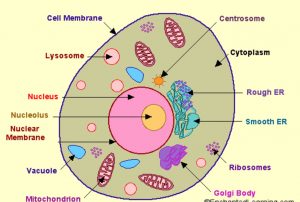Question 1 State few differences between animal cell and plant cell?
Question 2 Draw a labelled diagram of animal cell?
Question 3 Draw a labelled diagram of plant cell?
Question 4 What is cytoplasm? What is its function?
Question 5 What is cell membrane?
Question 6 what is nucleus? What is its function?
Question 7 What is the function of cell wall in plants?
Question 8 Where are chromosomes found in a cell?
Question 9 Write the function of mitochondria in a cell?
Question 10 What is protoplasm?
Question 11 What are vacuoles? Write its function?
Question 12 What is the function of chloroplast in plant cell?
Question 13 Why are plant and animal specimen usually stained with dyes?
Structure of Animal cell

1)A cell consist of a jelly like material enclosed in a thin membrane.The jelly like material which fills the cell is called cytoplasm.The function of cytoplasm is to carry out all the activities of the life processes.
2)The thin outer covering of the cell is called cell membrane.
3)There is a large floating body usually in the centre of a cell which is called nucleus.The function of nucleus is to control all the activities of the cell.
4)The nucleus contain a tiny round structure called nucleolus and a fibrous material called chromatin.It also has a nuclear membrane on the outside.Chromatin form chromosomes during cell division.These chromosomes transfer characteristics from the parents to the next generation.
5)The cytoplasm and nucleus taken together form the protoplasm of the cell.It is the living material of a cell.
6)There are a number of small bodies called mitochondria in a cell.The function of mitochondria is to carry out respiration for releasing energy from food.Since mitochondria produce energy from food, they are kind of power house of the cell.
7)The tiny air spaces in the cytoplasm of an animal cell are called vacuoles. The function of a vacuole in an animal cell is to hold air , water and particles of food.
8)The cell membrane is a thin sheet of skin all around the cell.The main function of cell membrane is to control the passage of materials which go into the cell or go out from the cell.It also protects the cell and gives shape to the cell.
Structure of Plant cell
1)A cell consist of a jelly like material enclosed in a thin membrane.The jelly like material which fills the cell is called cytoplasm.The function of cytoplasm is to carry out all the activities of the life processes.
2)There is a large floating nucleus in the cytoplasm.The nucleus contain a tiny round structure called nucleolus and a fibrous material called chromatin.It is surrounded by nuclear membrane.
3)There are a number of small bodies called mitochondria in a cell.The function of mitochondria is to carry out respiration for releasing energy from food.
4)All plant cell have thick cell wall all around the cell membrane.This cell wall is made up of cellulose.The cell wall protects the plant cell, gives it a fixed shape and makes it rigid.
5)The plant cell contain green coloured plastids called chloroplasts.They are green coloured bodies in the cytoplasm of the plant cell.They make food in green plants by the process of photosynthesis.Plant cell may contain plastids of different colours.
6)The plant cells have very large vacuoles.These vacuoles are filled with cell sap.It is a solution of sugars and mineral salts.
Staining of plant and animal specimen is done to identify the different components of a cell easily through the microscope.
For Ex:Dilute iodine solution, methylene blue, safranin.

Leave a Reply